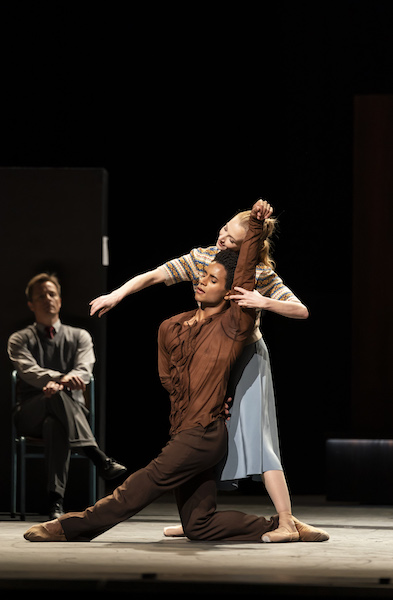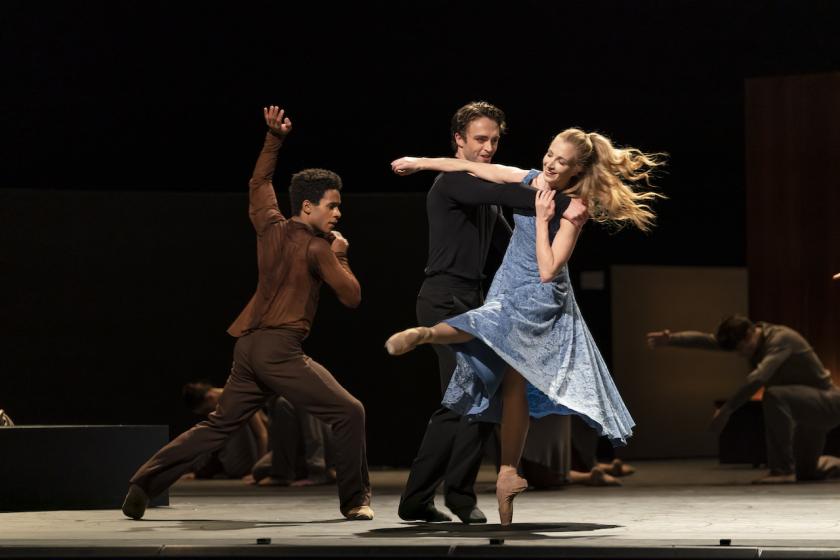The cello is the stringed instrument most closely aligned to the human voice. It has a human shape, too, so in theory it was a short step for choreographer Cathy Marston to give it a living, breathing presence in her ballet about the legendary cellist Jacqueline du Pré. But what a giant leap of imagination that turned out to be.
Marston’s first work for the main stage of the Royal Opera House, The Cellist is no straightforward biography, still less does it touch on the torrid accusations that fuelled the film Hilary and Jackie, which was based on a book by her siblings and vehemently disputed by her friends. Instead it focuses on the grand love affair between a musician and her instrument, an affair begun in childhood and cruelly curtailed by multiple sclerosis when du Pré was 26.
 On a minimal set (by Hildegard Bechtler) whose sleek wooden curves suggest the instrument’s own, the dancer Marcelino Sambé (pictured right) becomes a vivid embodiment of du Pré’s cello. He is not merely an object to be carted along to auditions and concerts, but a personality who responds to attention, pines when ignored, and sometimes elevates his owner (literally) to a higher plane. If this sounds twee then it’s a credit to the choreographer’s skill and Sambé’s commitment that the dramatic result is emphatically not.
On a minimal set (by Hildegard Bechtler) whose sleek wooden curves suggest the instrument’s own, the dancer Marcelino Sambé (pictured right) becomes a vivid embodiment of du Pré’s cello. He is not merely an object to be carted along to auditions and concerts, but a personality who responds to attention, pines when ignored, and sometimes elevates his owner (literally) to a higher plane. If this sounds twee then it’s a credit to the choreographer’s skill and Sambé’s commitment that the dramatic result is emphatically not.
Our first sight of Sambé is almost foetal, curled around a cello case on the floor – an old soul awaiting his next incarnation. Child Jackie (Emma Lucano from the Royal Ballet School), at her first lesson, struggles to stretch her bowing arm around Sambé’s broad chest, or spread her small hands on the fingerboard presented by his arm. As her talent takes wing, the body language grows in dynamism, the teenage Jackie (Lauren Cuthbertson) swaying and leaning in, with Sambé luxuriating in her wildly joyous embrace. Philip Feeney’s score stylishly intersperses his own music with exerpts from du Pré’s repertoire – Fauré, Rachmaninov, and of course the Elgar concerto. We see the effect on her of her first encounter, then marriage, with the pianist Daniel Baremboim – Matthew Ball a darting, forceful presence, less forceful as Jackie’s illness starts to bite.
How to present such a hideous personal tragedy without mawkishness? The Cellist comes close but doesn’t cross the line. Marston limits the visible symptoms to a hand tremble and a short scene in which du Pré, believing herself to be in remission, attempts a public recital but cannot start the first bar. Typically, Marston deploys the corps de ballet in myriad ways, as a classful of children, audiences, clamouring record buyers, and memorably as a full orchestra in which each dancer is both player and instrument. Ultimately, the tone of The Cellist is celebratory, underlined by a closing image of Sambé slowly and dreamingly spinning like a vinyl LP.
Dances at a Gathering, first mounted on the Royal Ballet in 1970, the year after its creation, completes the programme. Five couples in turn inhabit an uninterrupted sequence of Chopin piano waltzes, mazurkas and études (performed here from the pit by Rob Clark). These are not your usual bonded ballet couples. They swap about, form threesomes, break off into solos. They behave, in fact, like any group of friends. There is no story, although there is a compulsion to look for one within its lilting blend of folk and classical steps rehearsed to look casual. When Alexander Campbell first appears, alone, for the opening number, a Mazurka, he stands motionless for the first bars gazing at the floor. When he does try a few steps, he merely marks them, before eventually the music siezes him and he’s off.
The genius of this work, and its novelty, lies in the way the choreographer gets under the skin of the dance impulse. Done well, it feels less like a performance than a contemplation. You could have heard an eyelash drop during the closing Nocturne. What happened to all those winter coughs?














Add comment